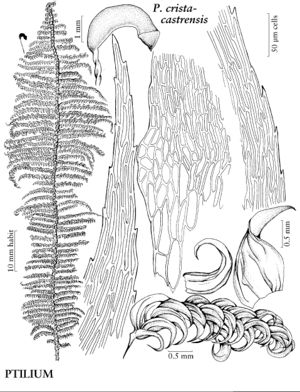Ptilium
Comment. Soc. Crittog. Ital. 2: 283. 1867.
| Taxon | Illustrator ⠉ | |
|---|---|---|
 | Ptilium crista-castrensis | Patricia M. Eckel |
Plants large, in loose mats, dark green to golden, shiny. Stems suberect to ascending, forming fronds, regularly pinnate; hyalodermis absent, central strand present, weak; pseudoparaphyllia foliose. Stem and branch leaves differentiated. Stem-leaves squarrose, broadly ovate, widest beyond base, strongly plicate; base not decurrent; margins plane, sharply serrulate distally; apex acuminate; ecostate or costa short, double; alar cells differentiated, rectangular or quadrate; laminal cells smooth; distal cells usually longer than 6: 1. Branch leaves usually circinate-secund, pointing toward base (not underside) of main shoot, oblong-lanceolate, tapering to apex, plicate, 1–2 mm; costa double, short; laminal cells long-linear. Specialized asexual reproduction absent. Sexual condition dioicous; perichaetial leaves lanceolate, apex subulate. Seta redbrown. Capsule horizontal, cylindric, arcuate, contracted below mouth; annulus narrow; operculum long-conic; peristome double; exostome teeth striolate basally, papillose distally; endostome basal membrane broad, segments broad, keeled, cilia 2 or 3, nearly as long as segments. Calyptra naked. Spores spheric, smooth to finely papillose.
Distribution
North America, Europe, Asia, terrestrial habitats in temperate, boreal, and subarctic regions
Discussion
Species 1.
Ptilium is a remarkably elegant genus that is usually easily distinguished from Hypnum, as the plants have extremely plicate circinate leaves that curve proximally, toward the base of the main stem, not ventrally to the underside of the stem as those in Hypnum. The exostome teeth are red-brown and lanceolate; the endostome is pale yellow.
Selected References
None.
Lower Taxa
"broad" is not a number.